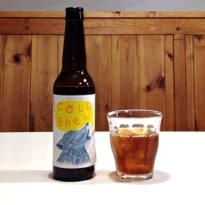In 2014, keeping pace with coffee can be an exhausting business. First came the flat white, then an explosion in drip-filter. Suddenly, the Aeropress was everywhere and, this summer, British coffee connoisseurs have been hailing a new breakout star: cold-brew.
Not to be confused with iced-coffee (in which hot or chilled espresso-based coffees are served over ice, often with milk and syrup), cold-brew is very much what it says on the tin. Coffee grounds are steeped in room-temperature water for up to 24-hours to produce a concentrated coffee essence which is then diluted with water, usually by 50%, and served chilled.
From seemingly nowhere, every third-wave coffee bar worth its salted caramel shortbread is on the case, from East London's Timberyard to Edinburgh's Brew Lab. Why? Because cold-brew produces a sweeter, less acidic drink which, certainly in the summer months, delivers a satisfying coffee flavour but in a new, refreshing format.
Wayne Lew, co-owner of Manchester's North Tea Power, which has recently been selling 200 bottles of cold-brew each week (at £3.50 each), says it is difficult to pinpoint quite why it has taken off this summer. He has been producing it, at a low-level, for four years, but, this year, interest has rocketed. It is just one manifestation, suggests Lew, of Britain's rapidly expanding interest in coffee: "Perhaps, once people have learned about one brew method they become interested in others. I remember when we set up the brew bar with the V60s, there weren't any of those about, so it was interesting to see that being done. We've always had the cold-dripper on the counter throughout summer, and people who wanted to ask about it would."
For coffee geeks and baristas, cold-brew is primarily fascinating because of the nuances in flavour it can highlight. The Nicaraguan single-origin blend I tried at North Tea Power, nattily packaged in a 330ml bottle that could easily have passed for a new craft beer, was full of bold chocolate flavours, with a hint of boozy warmth in its finish (it would make an excellent cocktail ingredient). "Because the brew method doesn't use heat, it doesn't extract bitter, acidic compounds, so it's juicy and sweet," says Lew. "We're not saying it's the best method, but it's interesting to play around with. For instance, if we use natural African coffees we can pull out really chocolatey, nutty flavours".
If all this is hot news in the UK, it's something the Japanese have known for centuries. Cold-brew, also known as Kyoto coffee, has been popular in Japan since the 1600s (Lew first learned about it reading trade magazines from the Japanese equipment supplier, Hario). It was reputedly introduced to Japan by Dutch traders from Indonesia, who possibly developed it as a way of producing large quantities of portable coffee, which they would later reheat or serve cold. In 2014, Lew says it is particularly useful for coffee fanatics who are travelling to summer festivals or going camping.
Not everyone is convinced, of course. There are those who think drinking cold coffee is nonsense, but, by the sounds of it, this is only the beginning of the cold-brew variations. North Tea Power is thinking about mixing it with almond or coconut milk and plan to nitro-keg it, like beer: "So you can get a Guinness like head on it. You could also make ice-cream and ice lollies out of it."
Is Britain ready for fizzy cold coffee? We shall see. But, in the meantime, have you tried cold-brew, and are you sold? Or is this more evidence of how modern coffee has lost the plot?
Make your own cold brew
In Japan, cold-brew is produced in handsome, slow glass-drippers, but you can easily replicate the effect at home. Take 120g-180g of coarsely ground, preferably single-origin coffee (you can tinker at pretty much every stage of this process to produce slight variations in the end product), and place that in a jug filled with a litre of water, fully immersing the coffee in it. Tightly cover the jug with cling film and either store it at room-temperature or in the fridge for around 16 hours. Two or three times, agitate the jug a little, to move the grounds around. Then slowly double or triple-filter the brew (North Tea Power uses nylon first and then a paper filter), until you have cleaned the brew of the visible spent coffee grinds. Like all filter coffees, it is comparatively high in caffeine at that point, so, in order that you do not end-up bouncing off the walls, it needs to be let down with around 50% water and then chilled, before serving - over ice if you wish.
Cold Brew ... for cool customers only?









